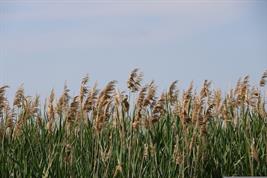24.10.2024
Press Release

A new study by the Leibniz Centre for Agricultural Landscape Research (ZALF), published in the journal
Ecosystem Health and Sustainability, analyses the current status and future options for transforming Europe's drained peatlands. The analysis shows the expected trends for drained peatlands: There are clear signs of a transition from drained arable land to grassland or wetland use. However, establishing economically viable business models for these land uses remains a challenge. The study highlights trends in land use, existing and future management practices and policy options.
Peatlands play a crucial role in climate change mitigation because they store large amounts of carbon. Although they cover only 3% of the world's land area, they absorb almost twice as much carbon as all the world's forests combined. However, especially in Europe, peatlands are being drained and used for agriculture. In the process, they release the stored carbon in the form of CO₂ and thus contribute significantly to global warming. Rewetting the land can halt this process.
For the study, the researchers conducted an online survey of 60 experts from eight European countries, asking about current and potential uses of rewetted peatlands and current trends. This was followed by workshops in Germany, the Netherlands and Finland with practitioners and researchers. The aim was to identify ways to expand the climate-neutral use of drained peatland soils in the future. From this, the researchers derived policy options at EU level.
Current use of peatlands, potentials and trends
In some countries, land use on drained peatlands is already shifting: moving away from arable farming towards wetland or grassland use. This shift is largely due to the increasing availability of economic options for utilizing these rewetted areas. The land can be used for grazing and hay production. In addition, paludiculture allows the cultivation of plants that thrive in wet conditions. This can provide sustainable raw materials such as reeds and peat moss for use in construction, insulation and energy production. Moreover, wetlands support biodiversity, provide recreational spaces for people, and offer essential ecosystem services such as water regulation.
However, these uses are less economically attractive, making the transition more difficult - especially where current practices generate high profits.
Policy implications and the role of the EU
The workshop participants emphasized the need to drastically reduce CO2 emissions from peatlands. However, this requires broad public support and economic incentives. EU policy plays a crucial role in developing measures to promote and support the transition in the long term. The interests of the various stakeholders must be reconciled.
"It is also important to provide economic incentives for the sustainable transformation of drained peatlands. Without the support of the agricultural sector and the public, such a transformation will be difficult to achieve," says
Dr. Cheng Chen, one of the lead researchers of the study. "Currently, paludiculture products have a very small market share. Value chains need to be significantly expanded. This requires industry partnerships for material processing and the expansion of the consumer framework to support the adoption and utilization of the new material", he adds.
Results and outlook
The study underlines that a successful transformation of peatland landscapes requires a differentiated approach, considering both the geoclimatic conditions and the interests of land users. A mix of economic incentives and adapted land-use models could support the transition to more sustainable practices, while helping to reduce greenhouse gas emissions.
Project partner:
- Leibniz Centre for Agricultural Landscape Research (ZALF), Müncheberg, Germany.
- Institute of Environmental Planning, Leibniz University of Hannover, 30419 Hannover, Germany.
- Leibniz Institute for Agricultural Engineering and Bioeconomy (ATB), Potsdam, Germany.
- Landesamt für Umwelt Brandenburg - Ministry of Agriculture, Environment and Climate Protection (MLUK), Brandenburg, Germany.
- Eberswalde University for Sustainable Development (HNEE), Eberswalde, Germany.
- Helmholtz Centre Potsdam - German Research Center for Geosciences (GFZ), Potsdam, Germany.
Funding:
DThe WetNetBB project (Management and Biomass Utilization of Wet Fens: Network of Model and Demonstration Projects in Peatland Regions of Brandenburg) is funded by the Federal Ministry of Food and Agriculture through the Climate and Transformation Fund. This research was made possible in part through funding by the PEATWISE project under the FACCE ERA-GAS Research Programme (under the European Union’s Horizon 2020 Research & Innovation Programme, grant agreement no. 696356).
Text disclaimer:
This is a summary of the original text generated by means of artificial intelligence: Chen, C., Lemke, N., Loft, L., Matzdorf, B. (2024) Transformation of peatland management toward climate targets in Europe. Ecosystem Health and Sustainability 10, Article 0239
https://doi.org/10.34133/ehs.0239, published under a Creative Commons Attribution License 4.0 (CC BY 4.0) https://creativecommons.org/licenses/by/4.0/.
The text has been carefully reviewed and revised in light of ZALF's AI policies.
 Press Release as PDF
Press Release as PDF
Further Information:
